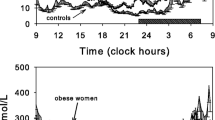Abstract
The dexamethasone suppression test (DST) is used to determine the sensitivity of the hypothalamic-pituitary-adrenal axis (HPA-axis) to negative feedback. Dexamethasone is usually administered at 23:00 h or at midnight but this is often not convenient. The aim of this study was to determine whether the administration of dexamethasone at 21:00 h as compared to 23:00 h would alter the degree to which 08:00 h plasma cortisol was suppressed the following morning. Three healthy males (mean±SE: 32±7 yr) and 3 healthy females (mean±SE: 35±7 yr) took part in the study. Each subject was orally administered 1 of 3 doses of dexamethasone (0.25 mg, 0.5 mg, or 1.0 mg) on 3 separate occasions in random order at least a week apart. Each dose of dexamethasone was taken at either 21:00 h or 23:00 h so that each subject underwent 6 tests. The differences in cortisol suppression between times and doses of dexamethasone were assessed using Analysis of Variance. Plasma cortisol was suppressed less in response to 0.25 mg dexamethasone at both 21:00 h and 23:00 h as compared with doses of dexamethasone of 0.5 mg or 1.0 mg (p=0.004). Suppression of plasma cortisol in response to each dose of dexamethasone was similar regardless of the timing of dexamethasone administration (p=0.5). We conclude that in healthy subjects 0.25 mg dexamethasone suppresses plasma cortisol less than either 0.5 mg or 1.0 mg and that 0.5 mg dexamethasone suppresses plasma cortisol to a similar extent as 1.0 mg dexamethasone. Moreover, changing the administration time of dexamethasone from 23:00 h to 21:00 h does not effect the degree to which cortisol is suppressed in healthy subjects.
Similar content being viewed by others
References
Wood P.J., Harth J.H., Freedman D.B., Perry L., Sheridan B. Evidence for the low dose dexamethasone test to screen for Cushing’s Syndrome — recommendations for a protocol for biochemistry laboratories. Ann. Clin. Biochem. 1997, 34: 222–229.
Crapo L. Cushing’s Syndrome: a review of diagnostic tests. Metabolism. 1979, 28: 955–977.
Aron D.C., Hershel R., Findling J.W. Effectiveness versus efficacy: The limited value in clinical practice of high dose dexamethasone suppression testing in the differential diagnosis of adrenocorticotropin-dependent Cushing’s Syndrome. J. Clin. Endocrinol. Metab. 1997, 82: 1780–1785.
Rupprecht R., Lesche K.P. Psychoneuroendocrine research in depression. J. Neural Transm. 1988, 75: 167–178.
Kosten T.R., Whaby V., Giller E., Mason J. The dexamethasone suppression test and thyrotropin-releasing hormone stimulation test in posttraumatic stress disorder. Biol. Psychiatry 1990, 28: 657–664.
Sachar E.J., Hellman L., Roffwarg H.P., Halpern F.S., Fukushima D.K., Gallagher T.F. Disrupted 24-hour patterns of cortisol secretion in psychotic depression. Arch. Gen. Psychiatry 1973, 28: 19–24.
Author information
Authors and Affiliations
Corresponding author
Rights and permissions
About this article
Cite this article
Barton, C., March, S. & Wittert, G.A. The low dose dexamethasone suppression test: Effect of time of administration and dose. J Endocrinol Invest 25, RC10–RC12 (2002). https://doi.org/10.1007/BF03344008
Accepted:
Published:
Issue Date:
DOI: https://doi.org/10.1007/BF03344008




